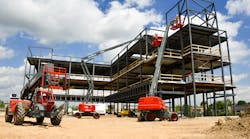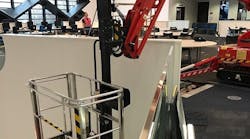RER is interviewing various manufacturers about customer reaction to Tier 4 products and where the industry will go from here. Mike Reinhart, marketing manager for Peterborough, U.K.-based Perkins Engines, sees huge benefits and advancements in engine technology.
RER: How has your customer base reacted to Tier 4 in the field?
Reinhart: Through our careful selection of technologies we have been able to deliver incremental customer value at U.S. EPA Tier 4 Interim and Final.
We have already accumulated over 51 million operating hours on nearly 100,000 Tier 4 Interim products in the field, with our engines operating in hundreds of different installations for leading global original equipment manufacturers.
We are very pleased that our customers have highlighted the performance, reliability, compact packaging, excellent transient response and fuel consumption of our latest engine range.
What will be some of the points of emphasis from this point on in terms of engine development?
Reinhart: Virtually all engines designed to meet U.S. EPA Tier 4 Final emission standards utilize some combination of four basic technologies, and will continue to do so in the coming decades. These key technologies are:
- Diesel Particulate Filters (DPF) that physically trap particulates in the exhaust stream.
- Cooled Exhaust Gas Recirculation (CEGR) or Exhaust Gas Recirculation (EGR) that lower combustion temperatures to minimize NOx formation.
- Diesel Oxidation Catalysts (DOC) help remove particulate matter from exhaust gasses, turning hydrocarbons and carbon monoxide into carbon dioxide and water. DOCs also aid the overall performance of after-treatment systems comprising DPF/Selective Catalytic Reduction.
- Selective Catalytic Reduction (SCR) that reduces NOx in the exhaust stream. Diesel Exhaust Fluid (DEF) that is injected into the exhaust gasses after the DOC/DPF and before the SCR to further reduce NOx. DEF consists of high-purity urea dissolved in de-ionized water meeting a specific, required concentration level – the industry standard being DEF which meets ISO 22241. It is stored in a dedicated tank and never comes into contact with the diesel fuel.
The exact technology mix for any given engine and application is arrived at by including everything needed to meet applicable regulatory standards while achieving customer performance requirements.
Having put in place the suite of technologies needed to achieve these near zero levels of emissions, the industry can now provide an even greater focus on enhanced customer value as the technologies mature and experience is gained.
How about alternative forms of fuel – biodiesel, biogas, synthetic diesel, methanol, etc.?
Reinhart:Both our U.S. EPA Tier 4 Interim and Tier 4 Final products are capable of operating on up to B20 biodiesel, provided the biodiesel meets certain ASTM specifications and is blended with Ultra Low Sulfur Diesel (ULSD) of 15ppm (U.S.).
What will be the next major trends in the engine industry overall as it pertains to construction equipment?
Reinhart: With the trend for downsizing machines, Perkins 1200, 850 and 400 Series allow equipment manufacturers great flexibility, while still benefitting from increased power density and fuel economy.
With increased power and torque across the Perkins range at Tier 4 Interim and Tier 4 Final, OEMs have a number of options available to them, dependent on their specific requirements.
The 1200 Series delivers 23 percent more power and 35 percent more torque compared to Tier 3 models, yet fuel consumption is better by 8 percent, allowing the end user to get more done, faster and with less fuel.
A 7-liter, 6-cylinder unit, capable of producing 300 hp, the 6 cylinder offering gives OEMs who may previously have chosen a larger engine, the choice of the same power from a smaller engine package. This also applies to the 4.4 liter, 4 cylinder engine, with the twin turbo after-cooled model delivering extra power and a faster response, coupled with a rating of 175 hp.
The same is true for the compact 850 Series, a 3.4 liter unit that can do the work of a much larger engine. With a huge 40-percent increase in power and up to 60 percent more torque available compared to Tier 3, the engine range gives great operating characteristics throughout the duty cycle.
Engine choice is very much driven by the sector and specific application. The flexibility and overlap in the powers across the Perkins range mean OEMs have a choice of engines to meet their specific application requirements. The key priorities for any OEM include productivity, transient response, reliability and flexibility. Across the Perkins engine range we have listened to our customers and designed products which meet their needs and which deliver excellent levels of transient response and support a machine’s ongoing productivity.
What trends do you see in the rental industry?
Reinhart: From a Perkins perspective it is critical that we proactively support the rental industry. The rental channel continues to increase in importance as contractors are opting to rent equipment instead of purchasing. Recent industry data suggests that over 50 percent of the contractors prefer to rent equipment and this upward trend is forecasted to continue to increase.
Our goal is to position and market Perkins as the preferred brand of choice to OEM and to rental businesses. The Perkins brand has an excellent reputation globally and is known for providing customers with a lifetime of low cost through ease of service and minimal maintenance. To achieve this goal, we must be “easy to do business with” from a parts and service viewpoint. To do this, Perkins has invested in and partnered with SmartEquip to help rental companies reduce transaction costs and improve operational efficiencies when ordering engine related parts.








